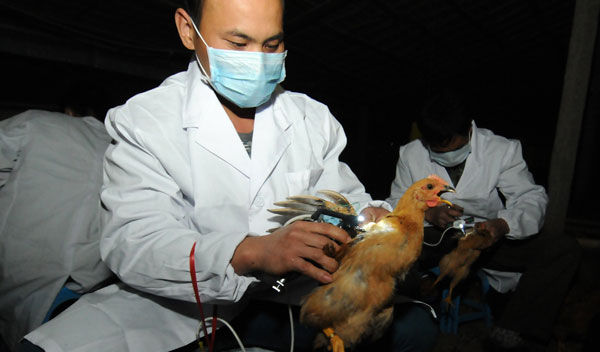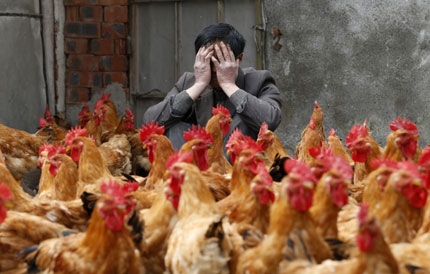It is exposed that China's entire chicken industry suffered a huge loss of 100 billion yuan in 2013.
The industry lost as much as 100 billion in 2013
The total loss of the industry in January 2014 is estimated to be about 20 billion.
According to the designated monitoring of the Ministry of Agriculture, the prices of poultry products fell instead of rising before the Spring Festival. In the fourth week of January, the price of live chickens was 17.31 yuan per kilogram, down 4.42 percent from the same period last year; and the price of eggs was 8.62 yuan per kilogram, down 10.21 yuan from the same period last year. According to the monitoring of the Agricultural products Wholesale Market Information Network of the Ministry of Agriculture, the sales of poultry products showed an abnormal decline before the Spring Festival. The trading volume of white-striped chicken in 27 wholesale markets in Beijing, Shandong, Jiangsu, and Shaanxi fell 8.0 percent in January 2014 compared with the same period last year, down 2.7 percent from the previous month.
According to the Ministry of Agriculture, sales volume and prices of commercial chicks have fallen, with prices of commercial egg chicks and broiler chickens both down 10 percent year on year in the fourth week of January 2014. According to the enterprise, the stock of large-scale chicken breeding enterprises in Guangdong Province has been reduced by 30%, 40%, and the amount of chicken seedlings has been reduced by more than 20%. A commercial chick in the main producing area of Jiangsu has lost 1 yuan.
"all the money earned in the past 10 years was lost last year." Cheng Enbao, head of Chengpeng Poultry Co., Ltd., in Dehui City, Jilin Province, had a particularly worrying Spring Festival-he had a net loss of 10 million yuan on raising chickens in 2013.
This is not a rare "bad luck" in the chicken industry: the "quick chicken" at the end of 2012 and the H7N9 flu outbreak in March last year, a crisis not seen in 30 years, is quietly driving the poultry industry to a cliff. According to data provided by the poultry branch of the China Animal Husbandry Association to reporters in Nandu, the entire chicken industry suffered a huge loss of 100 billion last year.
A reporter from Nandu went deep into Jilin and Guangdong and found that almost all parents, commercial chicken farmers, laying hen farmers and slaughterhouses were in serious losses.
But the crisis is far from over. With the continuous notification of H7N9 flu cases around the Spring Festival, this tragic situation is becoming more and more serious. Many farmers even asked in confusion: is this industry, which has more than 70 million practitioners, going to disappear?

Enterprises kill chickens for survival
The Department of Animal Husbandry of the Ministry of Agriculture provided Nandu reporters with data: according to the Ministry of Agriculture, the stock of white-feathered broilers dropped by 14.5 percent at the end of 2013 compared with 2012, and the number of white-feathered broilers is expected to decrease by 16.2 percent; the stock of yellow-feathered broilers is expected to decrease by 8.2 percent, and the number of laying hens is expected to decrease by 7.7 percent. The stock of laying hens shows a fluctuating decline, and the stock of laying hens at the end of 2013 is 11.5 percent lower than the same period last year.
Corresponding to the hard data is a harsh reality. The parent breeder chicken (after breeding, hybridizing and laying eggs among the designed strains, used to hatch and breed commercial chickens) breeding enterprises wait for breeding chickens to lay eggs and hatch into seedlings, and then supply the chicken seedlings to farmers through the "company + peasant household" model, and then buy them back, which is a common model in the chicken industry. However, in this round of crisis, parents on behalf of broiler breeding enterprises have become loss-making "hard-hit areas".
Lin Shuqing, the person in charge of Mingxing animal husbandry in Yongji County, Jilin City, has been in the chicken industry for more than 30 years. She is the second largest parent breeder in Jilin City. "I have never seen the downturn in this industry last so long and the losses can be so wide." Lin Shuqing felt very helpless.
The sharp fall in the market situation forced Lin Shuqing to continue to shrink the scale of breeding. "65000 sets were killed in August 2013 (the number of sets is the number of breeding chickens, for example, 100 sets refers to the sum of 100 hens and matching cocks), 46000 sets were killed at the end of November 2013, and now there are 110000 sets left." During the peak period, the breeding scale of his parents' breeding chicken was as high as 240000 sets. With such culling, Lin Shuqing suffered a loss of 11 million yuan.
There are countless enterprises that have experienced the same experience as Lin Shuqing. "for every set of broiler breeders killed, it will cost about 120 yuan." Cheng Enbao told reporters. Cheng Enbao raised 156000 sets of broiler breeders in 2013, but now there are only 46000 sets left. He also lost more than 10 million yuan. Sun Wanqi, from Wanxing Poultry Farm in Gongzhuling City, Jilin Province, said that in 2013, he raised a total of 36000 sets of broiler chickens, but now there are only 16000 sets left, resulting in a loss of 1.8 million.
Because no one wants the hatched chicken seedlings, parent breeder enterprises can only sell breeding eggs as commercial eggs. But it still can't stop the loss. According to Cheng Enbao, the current price of chicken seedlings is 0. 5%. 6 yuan per egg and 40 cents per egg, while the cost prices of the two are 2.5 yuan and 1.6-1.7 yuan respectively. If you turn it into a commercial egg at a loss, the market may not be able to open up. Lin Shuqing admitted that a year ago she still had more than 500 boxes of eggs that could not be sold. According to the standard specification of 360 per box, there are still 180000 breeding eggs.
Farmers are also struggling in Kaiping, Guangdong, thousands of miles away from Jilin, where high-quality chickens such as Sanhuang chickens in South China are produced. Although Huang Yonglu, president of Jiangmen Poultry Industry Association and general manager of Guangdong Shenhuang breeding Co., Ltd., has been in the industry for nearly 40 years, he is also deeply confused. The two enterprises he works for have lost nearly 100 million yuan. "if it goes on like this, I can't imagine what will happen. For enterprises, bankruptcy is bankruptcy, but it involves the livelihood of too many contract farmers. "
Enterprises that went bankrupt because of the broken capital chain began to emerge. Sun Shuqing, head of Shengxi feed processing farm in Dehui City, raised 90,000 sets at its peak, but he had to close the farm in September last year. Huang Yonglu said that in Kaiping, there has been an annual column of more than 1 million breeding enterprises bankruptcy exit, contract farmers lost all their money.
This is caused by a chain reaction. "as a result of the rapid decline in broiler consumption, there was a loss in sales; then it led to a decline in chicken seedling sales, and the supply of chicken seedlings was now at a loss; the loss effect was then transmitted to the parents' and grandparents' generation of chicken breeding enterprises." Chen Ying (Weibo) Feng, president of the Guangdong Poultry Industry Association, said the industry was losing money as a whole. In fact, the number of ancestral breeder chickens is small, the pressure is not too prominent; commercial generation of chicken seedlings, farmers do not make a profit can reduce the purchase of chicken seedlings. However, the parent breeder chicken lasted for more than a year, during which it kept hatching the chicken seedlings, and the parent breeder chicken breeding enterprises were in the most difficult situation.
Farmers quit
At the end of the entire aquaculture industry chain are many farmers of different sizes. According to the popular "company + peasant household" model, aquaculture enterprises usually give farmers a guaranteed recovery price. However, this has not allowed farmers to escape the fate of losses.
Zhao Lin (pseudonym) is a farmer in Buhai Town, Dehui City, Jilin Province. In mid-December last year, he just released 7500 white-feathered broilers. Breeding enterprises to 3.35 yuan per jin buyback, although the bottom buyback, but excluding feed, veterinary drugs and other costs, Zhao Lin this batch of chickens lost more than 10,000 yuan. "I was supposed to keep it for 40 days, but because the stock in the slaughterhouse was too large and reduced the number of chickens, I was forced to raise it for 50 days." Zhao Lin revealed that after the best fencing period, the meat ratio of chickens will be reduced, and the longer they are raised, the more losses they will lose. After this batch of chickens came out of the pen, Zhao Lin has not raised them any more.
"Nine of the ten henhouses around here are empty." Zhao Lin said.
Local farmers told reporters that the withdrawal phenomenon is widespread. Some farmers said that the outdoor temperature is more than ten degrees Celsius, the chicken house temperature is high, if there is a chicken roof chimney will emit white gas. If you don't get angry, it means you don't have it anymore.
Just a few hundred meters out of the chicken coop where Zhao Lin is located, the reporter saw three chicken sheds, without exception, the windows had been blown open by the cold wind, and the chimney had not a trace of white air. "I wonder if the industry is going to disappear." Zhao Lin, who has kept chickens for seven years, said he would not raise them again until the slaughterhouse said that the price of chickens had gone up.
- Prev

Poultry farming suffers from a cold winter, and chicken seedlings can only be burned if they can't be sold.
Poultry farming suffers from a cold winter, and chicken seedlings can only be burned if they can't be sold.
- Next

The bosses of Guangdong poultry enterprises run away: the poultry industry has lost more than 10 billion yuan
The bosses of Guangdong poultry enterprises run away: the poultry industry has lost more than 10 billion yuan
Related
- A course of planting techniques and methods on how to grow carrots
- How to plant the latest tulips?
- Is it better to pick tea in the morning or in the afternoon? When is the best time for tea to be picked? what is the third or fifth tea?
- Launch Yuanxiao Happy combination Haocha + Tea Yuan healthy Taste
- Penghu Tourism "Fireworks 20 Parade with You"
- 2022 West Lake Happiness holds "Digital Revitalization Voucher" and draws iphone13 and laptop.
- Banqiao Fuzhou social houses are designed to change start-up combined with police elimination to create a safe and livable environment
- The convenient measure of "mechanical weeding" in Xinbei has been abused and the Agriculture Bureau has imposed heavy penalties on the illegal land consolidation.
- Changgeng University Joins Hands with Four Memory Factories to Rescue Memory Talent Shortage
- The list of Taiwan's top 100 MVP managers is listed by the Director-General of the Farmers' Association of Sanxia District.

